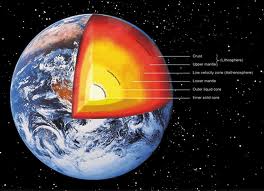Write a definition for the following concepts:
Crust:The crust is the surface layer.It is a thin ,solid layer made of rock.
Mantle:The mantle is the internediate layer.This layer is almost 85%of the Earths volume
Core:The core is the deepest layer
Magma. The magma is molten rock
ACTIVITY 2:
What temperature can be reached in the core of the earth?
The temperature in the core reaches about 4.500ºc
ACTIVITY 3:
Who was Alfred Wegener? What is Pangea?
Describe the evolution of Pangea and explain the relationship between tectonic plates and earthquakes.
Finally, name the most important tecnonic plates in the world.
Alfred Wegener outlined his continetal drift theory.According to this theory 200 millions years ago there was a single giant land mass,called Pangea .This Pangea was surrounded by a single ocean called Tethys Sea
ACTIVITY 4
How many continents do we have on planet Earth?
There are 6: America,,Asia,Europe,Africa,Oceanic,Antartic
How many continents do we have on planet Earth?
There are 6: America,,Asia,Europe,Africa,Oceanic,Antartic
Paste a map of the world with the name of the continents.
ACTIVITY 5
Name the most important oceans of the world. The mos important oceanin the world are the:Indian Ocean,Pacific Ocean,Antartic Ocean,Artic Ocean,Atlantic Ocean
Internal forces:Plate,volcanos
ACTIVITY 6:
The relief is the result of the internal forces of the earth and external agents.Write an example of the action of the internal forces. Name the external agents that cause the erosion and modeling of the Earth´s relief.External agents:Wind,rain,rivers....
ACTIVITY 7
Write a definition and find one image for the following concepts:
- Valley:They are sunken land and are sorrounded by mountains of ridge

- Plateu.Plateaux are large areas of high land .They are high well above sea level

- Hill:A hill is a landform that extends above the surrounding terrain.

- River:A river is a natural watercourse, usually freshwater, flowing towards an ocean, a lake, a sea, or another river. In a few cases, a river simply flows into the ground or dries up completely before reaching another body of water
-

- Delta :A landform atthe mouth of a river
-

- Estuary:An estuary is a partly enclosed coastal body of water with one or more rivers or streams flowing into it, and with a free connection to the open sea.
-

- Glacier:A glacier is a large persistent body of ice that forms where the accumulation of snow exceeds its ablation
-

- Groundwater:Groundwater is water located beneath the earths surface in soil pore spaces and...
-

- Lake.A lake is a body of relatively still water of considerable size, localized in a basin, that is surrounded by land apart from a river, stream, or other form of moving water that serves to feed or drain the lake.
-

- ACTIVITY 8 Natural Risks
What is a volcanic eruption? What consequences does it have?Explain what causes earthquakes. Does it have anything to do with tectonic plates?A volcanis eruption is an opening, or rupture , in a planet's surface or crust , which allows ... hazards, not only in the immediate vicinity of the eruption. ...A volcano






No hay comentarios:
Publicar un comentario